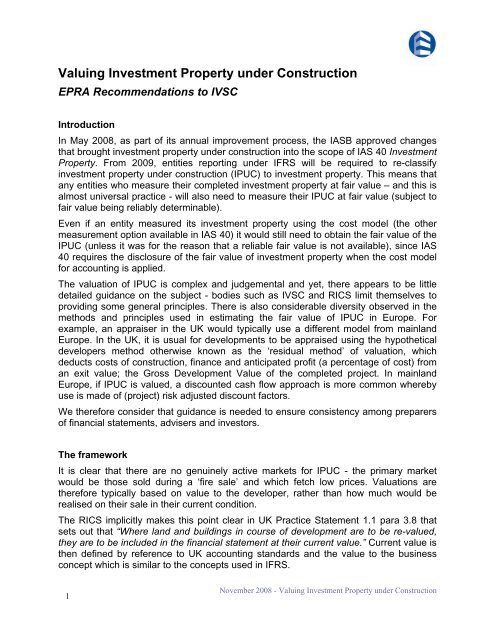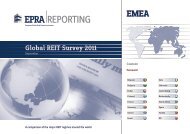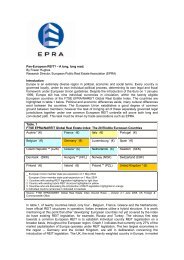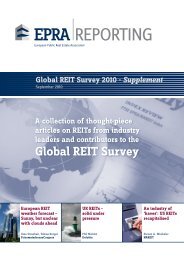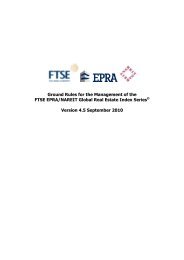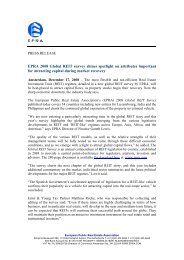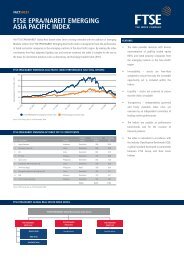Valuing Investment Property under Construction - EPRA
Valuing Investment Property under Construction - EPRA
Valuing Investment Property under Construction - EPRA
Create successful ePaper yourself
Turn your PDF publications into a flip-book with our unique Google optimized e-Paper software.
<strong>Valuing</strong> <strong>Investment</strong> <strong>Property</strong> <strong>under</strong> <strong>Construction</strong><strong>EPRA</strong> Recommendations to IVSCIntroductionIn May 2008, as part of its annual improvement process, the IASB approved changesthat brought investment property <strong>under</strong> construction into the scope of IAS 40 <strong>Investment</strong><strong>Property</strong>. From 2009, entities reporting <strong>under</strong> IFRS will be required to re-classifyinvestment property <strong>under</strong> construction (IPUC) to investment property. This means thatany entities who measure their completed investment property at fair value – and this isalmost universal practice - will also need to measure their IPUC at fair value (subject tofair value being reliably determinable).Even if an entity measured its investment property using the cost model (the othermeasurement option available in IAS 40) it would still need to obtain the fair value of theIPUC (unless it was for the reason that a reliable fair value is not available), since IAS40 requires the disclosure of the fair value of investment property when the cost modelfor accounting is applied.The valuation of IPUC is complex and judgemental and yet, there appears to be littledetailed guidance on the subject - bodies such as IVSC and RICS limit themselves toproviding some general principles. There is also considerable diversity observed in themethods and principles used in estimating the fair value of IPUC in Europe. Forexample, an appraiser in the UK would typically use a different model from mainlandEurope. In the UK, it is usual for developments to be appraised using the hypotheticaldevelopers method otherwise known as the ‘residual method’ of valuation, whichdeducts costs of construction, finance and anticipated profit (a percentage of cost) froman exit value; the Gross Development Value of the completed project. In mainlandEurope, if IPUC is valued, a discounted cash flow approach is more common wherebyuse is made of (project) risk adjusted discount factors.We therefore consider that guidance is needed to ensure consistency among preparersof financial statements, advisers and investors.The frameworkIt is clear that there are no genuinely active markets for IPUC - the primary marketwould be those sold during a ‘fire sale’ and which fetch low prices. Valuations aretherefore typically based on value to the developer, rather than how much would berealised on their sale in their current condition.The RICS implicitly makes this point clear in UK Practice Statement 1.1 para 3.8 thatsets out that “Where land and buildings in course of development are to be re-valued,they are to be included in the financial statement at their current value.” Current value isthen defined by reference to UK accounting standards and the value to the businessconcept which is similar to the concepts used in IFRS.1November 2008 - <strong>Valuing</strong> <strong>Investment</strong> <strong>Property</strong> <strong>under</strong> <strong>Construction</strong>
We have called this a ‘mark to model’ approach and, as the name suggests, itnecessitates the use of a valuation model. It is the principles behind such models thatare the focus of this recommendation.Project gainsThe gain associated with realising a project, and discussed in this paper, comprises thefull gain that will accrue to the developer from the initial planning consent until theproperty is complete. In certain jurisdictions, development activities are separated fromasset management and investment property activities - typically a developmentcompany develops the property, and on completion transfers it to the investmentcompany to manage. An issue that might then arise is which part of the gain isattributable to the development company - for example a substantial part of the projectgain is due to the letting process, and that might be said to be either an assetmanagement activity or a development activity. Although important, this paper does notattempt to distinguish between the two and assumes the development takes place inone single entity or from a consolidated perspective.Moreover, an increase in value of a project over time may be the result of a wholevariety of reasons, including but not limited to development activities, macro and microeconomic circumstances, occupier fundamentals and changes in the capital markets.Therefore, even if a project has increased in value over time it will not be possible toisolate the gain realised from development activities from the other factors referred toabove.Project lossesIn some circumstances the development process may not realise a project gain. Projectvalues may decrease during the development process due to (i) economiccircumstances, changes in market conditions or changes in occupier fundamentalsreducing the projected value of the completed property and/or (ii) development costsexceeding budgets/forecasts.The principles set out below assume that a project gain will be achieved. Situationswhere project losses arise have not been dealt with in this paper.Redevelopment projectsFinally, we note that the principles outlined below would also be applicable to valuingexisting investment property <strong>under</strong>going major refurbishment.The principlesAt the recent <strong>EPRA</strong> meeting in Stockholm, held on September 03, 2008, a series of 14principles were presented to a roundtable of representatives from the real estate2November 2008 - <strong>Valuing</strong> <strong>Investment</strong> <strong>Property</strong> <strong>under</strong> <strong>Construction</strong>
industry including European listed property companies, investors, advisors andappraisers.The principles that were agreed in that meeting are listed below:1. The starting point of any valuation of IPUC should be a completed property. Such avaluation should be based on current valuations applicable to similar existingcompleted properties with comparable encumbrances to property rights. In practice,property is not usually fully let on completion, but an appraiser will still be able tovalue the IPUC and should normally be able to demonstrate possible scenarios.2. The gain which may be attributable to realising project objectives is the differencebetween the value of a completed building and its construction costs - including thecost of the land, finance costs incurred during construction and any directlyattributable costs.3. Project risks are all risks associated with realising the project objectives. Theexistence of unmitigated project risks is a key factor in arriving at the fair value ofIPUC. The significant project risks associated with the development should beidentified.4. When project risks are minimised or eliminated, a degree of project gain may havebeen achieved and the value of the project increased. However, project gain shouldonly be recognised in a valuation of an IPUC when a substantial amount of theproject risks have been reduced or eliminated. An appraiser should disclose thesignificant judgements used in determining the stage at which a substantial amountof the project’s risks have been eliminated (see also 7 below).5. The above notwithstanding, if the land has increased in value - perhaps via the issueof government permits - and comparable prices exist for land in that condition in anactive market, then that part of the project gain should be recognised.6. Valuations should be based on project cash inflows and outflows, taking into accountthe time value of money and remaining project risks. The cash outflows must includeall construction and other project costs still to come, based on contracted terms andcurrent best estimates.7. Transparency of the valuation estimate is important. The appraiser should include adescription of their valuation methodology and the key assumptions used in theirreport to the client. In particular, the appraiser must also identify how the remainingrisks of the project have been dealt with in the valuation - any contingent element,deductions or risk adjusted discount rates should be quantified and explained withreference to the remaining project risks.We have included in Appendix I the rationale for these agreed principles. A number ofother principles were not adopted during the meeting and these are listed in Appendix II.The attendees at the meeting are listed in Appendix III.3November 2008 - <strong>Valuing</strong> <strong>Investment</strong> <strong>Property</strong> <strong>under</strong> <strong>Construction</strong>
ConclusionThe principles recommended in this paper are supported by <strong>EPRA</strong>, and with the supportof the IVSC, should provide the following industry benefits:• a consistent approach• transparency• a clear link between IAS 40 and the valuation practice• explicit recognition that key projects risks <strong>under</strong>lying the valuation must beidentified and addressed• guidance on what constitutes a ‘reliable’ valuationIt is true to say that more detailed or prescriptive guidance would lead to morestandardisation – but a balance must be achieved between (i) the need for a consistentapproach; and (ii) professional consideration of the unique circumstances and risks thatattach to each project. We consider that the principles set out above do achieve theright balance, and we therefore recommend both that IVSC adopts these principles andincorporates them in their formal valuation guidance.AttachmentsI Principles agreed uponII Principles rejectedIII List of attendees4November 2008 - <strong>Valuing</strong> <strong>Investment</strong> <strong>Property</strong> <strong>under</strong> <strong>Construction</strong>
Appendix I - Basis for conclusionsPrinciple1. The starting point of any valuation of IPUC should be acompleted property. Such a valuation should be based oncurrent valuations applicable to similar existing completedproperties with comparable encumbrances to property rights.In practice, property is not usually fully let on completion butan appraiser will still be able to value the IPUC and shouldnormally be able to demonstrate possible scenarios.Reference to <strong>EPRA</strong> Meeting: Principle 1.2. The gain which may be attributable to achieving and realisingproject objectives is the difference between the value of acompleted building and its construction costs - including thecost of the land, finance costs incurred during constructionand any directly attributable costs.Reference to <strong>EPRA</strong> Meeting: Principle 2.RationaleWhatever model is used to estimate the value of IPUC, it is necessary to start withan estimation of the value of the finished property. There are many different modelsto do this, including a yield approach or a DCF. The selection of a model will oftendepend on market practice. Any estimation of a finished property will involvejudgement or estimates; for example of the market rent and discount rate/yield oncompletion. An appraiser should therefore be able to estimate the value of thefinished property <strong>under</strong> different assumptions taking into account estimatedvacancy costs.The gain which may be attributable to achieving and realising project objectives isthe most subjective area of the valuation. In particular, the question of when such again - and the quantum thereof - should be recognised in a valuation. It is thereforeimportant to first define what is meant by a value increase of the project.Some attendees believe that such an increase in the value of a development projectshould simply be referred to as a development gain. However, the nature andreason of any value increase is a complex and judgemental area. Inter alia projectvalues may have increased due to, for example:- development activities;- economic circumstances;- changes in market conditions;- changes in occupier fundamental;- synergies with other projects or existing investment properties.Hence, one cannot say or even prove that if a project has increased in value that,by definition, such value increase is solely and exclusively attributable to thedevelopment activities. Therefore, these principles avoid the description‘development gain’ - rather, the neutral wording ‘project gain’ is used.Some attendees believed there could be confusion about directly attributable costs.For instance, IFRS does not allow capitalisation of selling costs, general overheadand research costs etc. However, fair value of IPUC is an exit value. Costs aretaken into account in the valuation process to the extent deemed necessary toarrive at that exit value.5November 2008 - <strong>Valuing</strong> <strong>Investment</strong> <strong>Property</strong> <strong>under</strong> <strong>Construction</strong>
Principle3. Project risks are all risks associated with realising the projectgain. The existence of unmitigated project risks is a key factorin arriving at the fair value of IPUC. The significant projectrisks associated with the development should be identified.Reference to <strong>EPRA</strong> Meeting: Principles 3 and 5.4. When project risks are minimised or eliminated, a degree ofproject gain may have been achieved and the value of theproject is increased. However, a project gain should only berecognised in a valuation of an IPUC when a substantialamount of the project’s risks have been reduced or eliminated.Reference to <strong>EPRA</strong> Meeting: Principles 4 and 6.5. The above notwithstanding, if the land has increased in value- perhaps via the issue of government permits - andcomparable prices exist for land in that condition in an activemarket, then that part of the project gain should berecognised.Reference to <strong>EPRA</strong> Meeting: Principle 13.RationaleProject risk and reward are inextricably linked. Every project has a number ofgeneric and unique risks. To the extent these risks have not been eliminated, theyare a key driver in determining the fair value of any IPUC. Therefore whenconsidering project gain, it is necessary for an appraiser to identify those projectrisks which are significant to the project and its fair value at the valuation date.IAS 40 only allows IPUC to be carried at fair value if the valuation is sufficientlyreliable. This implies that sufficient risks have been eliminated. As the objective ofany guidance paper is not to be prescriptive, we consider that guidance that a‘substantial’ amount of risk be eliminated is appropriate.It is deliberate that no further guidance has been provided as the appraiser willneed to consider the individual facts and circumstances of a development in makingthis judgement. Not only might they differ from project to project, but also frommarket to market and can be dependent on the economic climate. However, it isimportant that an appraiser discloses how this judgement is made. For example, ifcertain hurdles are set prior to project gain being recognised - for example apercentage of the development physically complete or a percentage of the buildingsuccessfully let – then these should be disclosed.As noted, the valuation of IPUC is typically carried out on a ‘mark to model’ basis.However, if there is an opportunity to use a ‘mark to market’ method for an elementof the IPUC, then it would be appropriate to do so. This implies a two-stagerecognition approach may be appropriate: the incremental value resulting fromzoning and permits and the remainder of the development process. For example, itmay be that the appraiser does not consider it appropriate to include any projectgain in the ‘construction asset’ if the development has not yet progressedsufficiently (i.e. the appraiser may still consider the fair value of that part to be thesame as cost). However, if in this situation, the land element of the developmenthas an identifiable fair value by reference to market transactions, then that shouldbe taken into account.Some attendees believed this is not in line with paragraph 51 of IAS 40. Indeed,future capital expenditure that will enhance the benefits may not be taken intoaccount in determining the fair value, nor may the income that might arise from thisexpenditure. However, it is common for the value of land to reflect its potentialfuture use, and the value of land may increase in the event that the owner obtains6November 2008 - <strong>Valuing</strong> <strong>Investment</strong> <strong>Property</strong> <strong>under</strong> <strong>Construction</strong>
Principle6. Valuations should be based on project cash inflows andoutflows, taking into account the time value of money andremaining project risks. The cash outflows must include allconstruction and other project costs still to come based oncontracted terms and current best estimates.Reference to <strong>EPRA</strong> Meeting: Principles 7, 8 (partially), 10and 11.7. Transparency of the valuation estimate is important. Theappraiser should include a description of their valuationmethodology and the key assumptions used in their report tothe client. In particular, the appraiser must also identify howthe remaining risks of the project have been dealt with in thevaluation - any contingent element, deductions or riskadjusted discount rates should be quantified and explainedwith reference to the remaining project risks.Reference to <strong>EPRA</strong> Meeting: Principle 14.Rationaleany required permissions for a change in the use of that land. It may be, forexample, that a permission to change from an industrial to residential use willincrease the value of the property as a whole, not withstanding that the existingindustrial buildings are still in place. This increase in value is typically attributable tothe land, rather than the buildings.If that value increase reflects the market value of the land, i.e. it is what every buyerof the land would incorporate in the price they are willing to pay, it would beappropriate to record any changes in value resulting from the receipt of suchpermissions in the fair value of the land. But, if the increase in value is entityspecific,for instance, if the benefit of the permission was only available to thatowner and not the market generally, then no additional value can be recorded forthe land.This paper is not prescriptive about a valuation method, but any method must takeinto account the time value of money and contracted cash flows. Other non-contractcash outflow estimates must be estimated according to market prices.As noted previously, the valuation of IPUC is both complex and judgemental. It istherefore important that an appraiser’s report informs the user of the valuationmethod and key assumptions. The appraisers report may be used for corporategovernance purposes and to assist in the preparation of the financial statements.We also note, for example, that IAS 40 requires disclosure of the methods andsignificant assumptions applied in determining the fair value of investment property,including a statement whether the determination of fair value was supported bymarket evidence or was more heavily based on other factors (which the entity shalldisclose) because of the nature of the property and lack of comparable market data.7November 2008 - <strong>Valuing</strong> <strong>Investment</strong> <strong>Property</strong> <strong>under</strong> <strong>Construction</strong>
Appendix II – Rejected principlesPrinciple1. If risk is not explicitly allowed for elsewhere in the valuationprocess - for example construction costs and GDV - then:a) the discount rate should reflect the market riskpremium, and is by definition higher than the rateused for valuing the completed and fully let property;b) different rates may be necessary on differentelements - for example a higher discount rate foroutgoings (higher risk = lower discount rate) ascompared with income (higher risk = higher discountrate).Reference to <strong>EPRA</strong> Meeting: Principle 8 (partially).2. The required risk premium should be based on the premiumtypically required by developers in the subject market at theeffective date of the valuationReference to <strong>EPRA</strong> Meeting: Principle 9.3 Project uncertainties which are not reflected in the riskpremium must lead to an even higher discount factor, or to alower project gain, or must be factored in via othertechniques such as the Real Options Model or Monte CarlosimulationReference to <strong>EPRA</strong> Meeting: Principle 12.RationaleThis was found too prescriptive. The attendees, however, agreed with the generalprinciple that project risks should be explicitly allowed in the valuation. It is theappraiser who must identify how he has factored in the remaining risks into thevaluation.As aboveAs above.8November 2008 - <strong>Valuing</strong> <strong>Investment</strong> <strong>Property</strong> <strong>under</strong> <strong>Construction</strong>
Appendix III - Attendees at the <strong>EPRA</strong> roundtable meeting in StockholmAd Buisman (Chairman)Gareth LewisPeter van RossumBert Jaap DijkstraOlivier ElamineMarcus PostLuciano GabrielJan HaarsGraham RobertsDavid SleathDennis De VreedeArjan SpruitCraig HughesMatt WilliamsHans GrönlohJonathan ThompsonChris ThorneAndrew BarberErnst & Young<strong>EPRA</strong>Unibail Rodamco(Chairman of <strong>EPRA</strong> Reporting &Accounting Committee)Unibail RodamcoAlstriaING Real EstatePSP Swiss <strong>Property</strong>CorioBritish LandSEGRORedevCoRedevCoErnst & YoungErnst & YoungKPMGBPF / KPMGIVSCRICS / CBREFor any comments on these recommendations, contact Gareth Lewis:gareth.lewis@epra.com, or call: +31 20 405 3841About <strong>EPRA</strong>The European Public Real Estate Association - is the voice of the publicly tradedEuropean real estate sector.With more than 200 active members, <strong>EPRA</strong> represents over EUR 300 billion of realestate assets and 85% of the market capitalisation of the FTSE <strong>EPRA</strong>/NAREIT EuropeIndex. <strong>EPRA</strong> works to encourage greater investment in listed real estate companies inEurope through the provision of better information to investors, improvement of thegeneral operating environment, encouragement of best practices and the cohesion andstrengthening of the industry,9November 2008 - <strong>Valuing</strong> <strong>Investment</strong> <strong>Property</strong> <strong>under</strong> <strong>Construction</strong>


